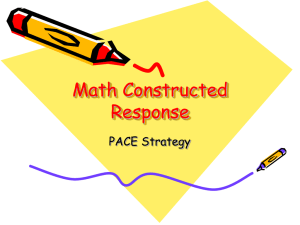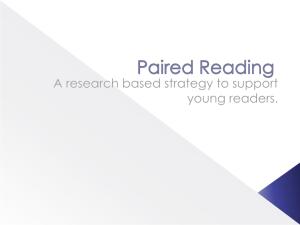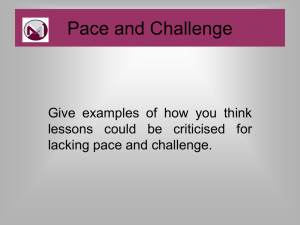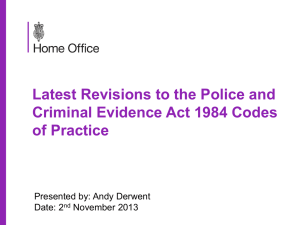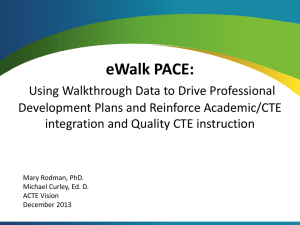Kolmanold
advertisement
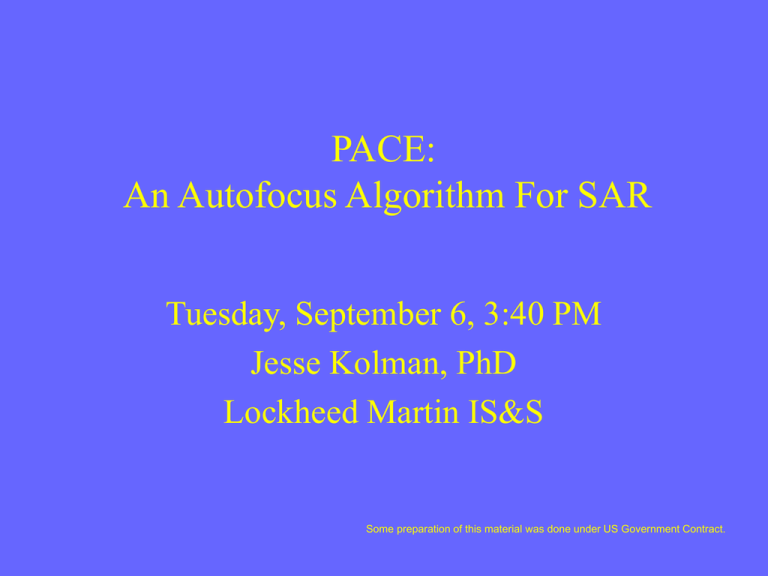
PACE: An Autofocus Algorithm For SAR Tuesday, September 6, 3:40 PM Jesse Kolman, PhD Lockheed Martin IS&S Some preparation of this material was done under US Government Contract. Focusing Spotlight Mode Data N 1 f i ( n) u i ( k ) e j 2nk / N k 0 where f i (n) focused (azimuth compressed) image u i (k ) unfocused (range compressed) data i = range bin n= image azimuth position k= aperture position SAR Autofocus • Image corrupted by phase error – Multiplicative error in azimuth phase history domain – Independent of range • Results in blurring due to wider impulse response • Benefits of estimating phase error – Image quality improvement – Phase error of intrinsic value in some applications Causes of Phase Error • Non-planar terrain • Platform motion deviations • Atmospheric effects • Hardware characteristics • Software approximations Phase Error Model j ( k ) ~ ui (k ) u i (k ) e , u i (k ) ~ u i (k ) (k ) where Uncorrupted azimuth phase history Data corrupted by phase error Phase correction Phase Adjustment by Contrast Enhancement (PACE) • Maximizes contrast • Uses gradient-based optimization algorithm • Versions exist for both strip-mapping and spotlight mode SAR • Fast quadratic version exists Contrast Definition 1 C M M 1 1 i N N 1 i σi i 0 μi f n 0 i Contrast of image is average of contrast of range bins ( n) 2 1 N 1 f i ( n) i N n 0 Contrast of range bin is ratio of standard deviation of pixel magnitudes to mean of pixel magnitudes Optimization Algorithm • Contrast is maximized using conjugate gradients or quasi-Newton algorithm • Requires explicit formula for gradient of contrast with respect to phase corrections • Iterative – Typically requires 10 – 100 iterations – Each iteration is itself iterative, requiring 2 – 3 function and gradient calculations Gradient of Contrast M 1 dC * i Imu i (k )q(k ) , where d (k ) i 0 1 1 i and i MN i i N 1 q(k ) n 0 f i (n) j 2nk / N e f i ( n) Computational Efficiency • Bulk of calculations are FFTs • Algorithm is parallelizable • Adjustable tradeoff between speed and accuracy – Number of iterations – Fraction of range bins used High Order Phase Error Image Blurred by High Order Phase Error Image Restored Using PACE SAR Image Before and After PACE Contrast = 0.626 Contrast = 0.759 Contrast vs. Iteration Assessment of Phase Estimate Accuracy • Real SAR image fully focused using algorithm to be tested • Phase error incorporated into azimuth phase history data • Additive, white, Gaussian noise applied in measurement domain • Autofocus performed • Result compared to applied phase error RMS Errors for PGA and PACE SNR PGA PACE No Noise 6.0 0.0064 10 dB 6.2 2.0 3dB 7.2 4.9 0dB 8.2 8.1 Residual RMS Errors in Degrees Accuracy vs. Speed Comparison • Phase Gradient Algorithm (PGA) run to convergence, time and RMS error recorded • PACE run for maximum number of iterations possible in less time than PGA required • PACE run for minimum number of iterations required to produce lower RMS error than PGA Accuracy vs. Speed for PGA and PACE Algorithm CPU time (seconds) RMS Error (degrees) PGA 13.4 6.0 PACE 13.1 3.2 PACE 6.4 5.8 Advantages of PACE • Nonparametric • Highly accurate • Computationally efficient • Robust in the presence of noise • Virtually independent of scene content Quadratic Version of PACE • Common causes result in quadratic phase error – Constant terrain height error – Azimuth velocity discrepancy – Range acceleration • Single parameter problem reduces optimization algorithm to line search • Derivative of contrast with respect to parameter still needed for efficient maximization Quadratic Phase Error Equations • Model for phase error (k ) ak k 0 • Derivative of contrast with respect to parameter a dC M 1 N 1 2 * i Im (k k 0) ui (k )q(k ) da i 0 n 0 Quadratic Autofocus Algorithm Comparison • Standard algorithms (Mapdrift, Phase Difference) have nominal accuracy of 90 degrees • One function call to PACE takes about twice as long as these algorithms • Standard algorithms can achieve improved accuracy proportional to increased processing time Accuracy vs. Function Calls for Quadratic PACE Absolute Error 0.777504 0.033050 0.001378 0.000307 0.000058 0.000021 0.000009 Function Calls 3 5 7 10 14 16 18 Conclusions • PACE is an accurate and efficient nonparametric autofocus algorithm • Produces maximum contrast • Performs well in the presence of noise • Does not depend explicitly on scene content • Quadratic version achieves accurate results with fast one-dimensional search
